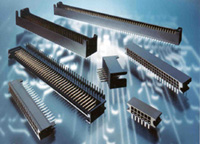 Photo ©1998 AMP INC.
Photo ©1998 AMP INC.This section of the design guide is concerned with the selection factors which influence connector reliability. In the section titled Properties of Coppers & Copper Alloys, mechanical and physical properties were tabulated so that alloy familiarity was accomplished. These properties impact selection decisions because they affect connector performance, as was shown in the section called Selection of Copper Alloys for Connectors. It was shown that many of these properties had a direct effect on performance. For example, without sufficient electrical conductivity, connector components can malfunction due to resistive overheating.
For such characteristics it is possible to perform tests on initial production parts or on prototypes to quickly ascertain how connector performance is affected. But not all connector requirements lend themselves to such immediate testing. An obvious example is the need to maintain a minimum contact force throughout the design life, not just during tests of initial circuit integrity. Failures during prototype tests are discouraging and delay project completion. Failures on initial production parts are obviously worse. But connector failures on parts already in the field are the worst of all, for they may even risk the life of the business.
It is this latter concern for performance over time, termed reliability, that is addressed in this section. The properties of strip metals that affect connector performance over time are evaluated and compared. All alloys are affected to some extent by the ravages of time but some alloys resist particular degradation better than others. Thus, just as alloy selection was important to meet initial design requirements, it is critical for performance over time.
-
-
- Overview of Stress Relaxation
- Stress Relaxation Tests
- Alloy Selection for Stress Relaxation
- Time Affects Stress Relaxation
- Temperature Affects Stress Relaxation
- Initial Stress Level Affects Stress Relaxation
- Orientation Affects Stress Relaxation
- Temper Affects Stress Relaxation
- Fatigue Strength
- Factors Affecting Fatigue Strength
- Interface Corrosion
- Stress Corrosion Cracking (SCC)
- SCC Susceptable & Resistant Alloys
- Tin Coatings
- Tin Whiskers
- Copper-Tin Intermetallic Compounds
- Effect of Time and Temperature on Copper-Tin
- Contact Resistance When Using Tin Coatings
- Friction When Using Tin Coatings
-
